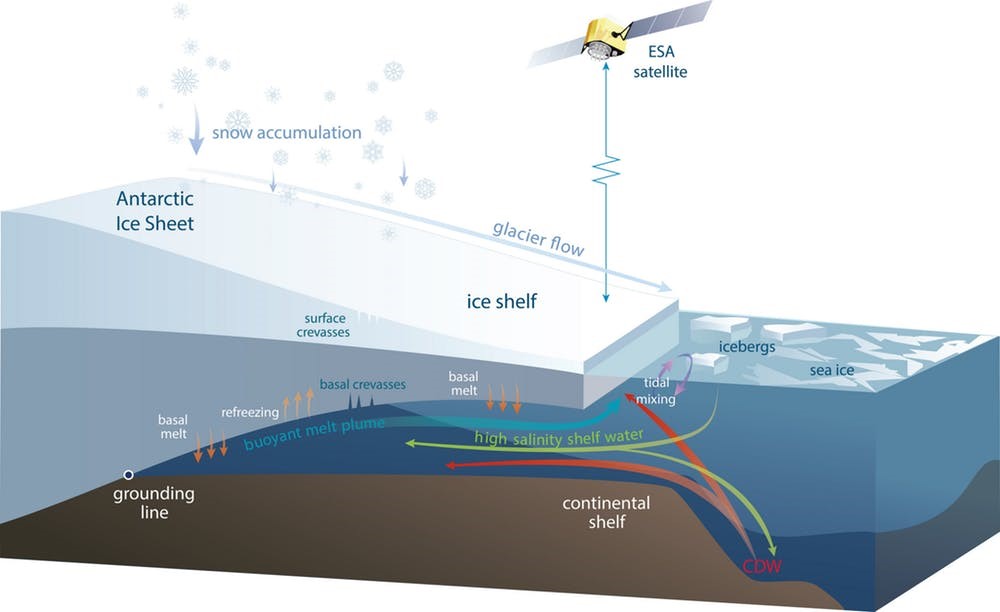Antarctic floating ice walls protect against warming seas

Schematic diagram of an Antarctic ice shelf showing the processes causing the volume changes measured by satellites. Ice is added to the ice shelf by glaciers flowing off the continent and by snowfall that compresses to form ice. Ice is lost when icebergs break off the ice front, and by melting in some regions as warm water flows into the ocean cavity under the ice shelf. Under some ice shelves, cold and fresh meltwater rises to a point where it refreezes onto the ice shelf (Source: Helen Amanda Fricker, Professor, Scripps Institution of Oceanography, UC San Diego, Shrinking of Antarctic ice shelves is accelerating, The conversation, March 27, 2015).
The Antarctic Ice Sheet contains enough ice, if melted, to raise global sea levels by tens of metres. A new study by Wåhlin et al., published in the journal Nature, shows that floating ice walls offer some protection to the ice sheet by deflecting warm ocean currents, that would otherwise penetrate cavities beneath the floating portions of the ice sheet.
In this paper, an international research group has explored the physics behind the warm ocean currents that surround the Antarctic coast. It is a step forward in understanding heat delivery to the Antarctic Ice Sheet.
CSHOR is one of several organisations supporting the research and is duly acknowledged by the authors of the paper.
“The Antarctic Ice Sheet reaches the ocean through ice shelves, which are the floating edges of the ice sheet. Like a dam wall, these ice shelves slow down the rate at which grounded ice is discharged to the ocean, where it melts and contributes to sea-level rise,” says CSHOR researcher Dr Laura Herraiz-Borreguero, a co-author of the study.
“Improving our understanding of the stability of the Antarctic Ice Sheet, and the processes which could slow or speed it’s rate of melt, are of huge importance to society. We do know that one important control on ice loss from Antarctica is what happens where the ice sheet meets the ocean. It is here where a large amount of ice melts.”
The question of how warm ocean currents make their way to the ice sheet, beneath the floating ice shelves, has been a long unanswered question for researchers. Further understanding has been gained by studying data collected from instruments that the study team placed in the ocean in front of the Getz Ice Shelf in West Antarctica.
The Getz Glacier culminates in a vertical edge, a floating wall of ice that continues 300–400 metres down into the ocean. Warm ocean currents flow beneath this edge, towards the deeper grounded ice. The study found that the warm ocean currents are blocked by the floating ice edge. This limits the extent to which the warm ocean can reach the ice. The researchers now understand that only around one-third of the thermal energy that travels up towards the Antarctic Ice Sheet from the deep Southern Ocean reaches the ice.
The results of the study have provided researchers with a greater understanding of how these glacier areas work. The density structure of the water column, thus the relative magnitude of barotropic to baroclinic components of the current, is a better indicator of ice shelf melt than heat transport onto the continental shelf.
“Our work highlights the importance of the floating ice shelves, and in particular, their ice fronts, as key areas that should be closely monitored. If the ice front walls were to thin and disappear, a much greater portion of ocean heat would be delivered towards the grounded Antarctic ice.”
Researchers believe that the studies have provided them with significantly better tools to be able to predict future sea-level rise.
In March 2020, the AZoCleantech website published an article regarding the paper at this link. There was also a similar article on the Mirage News website.